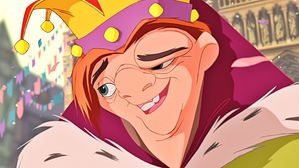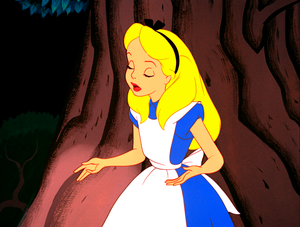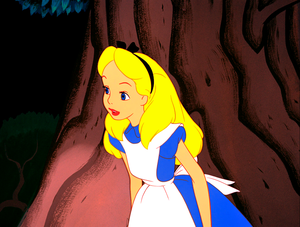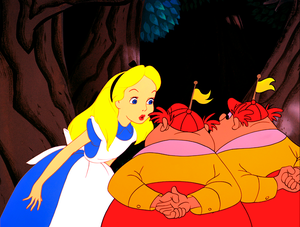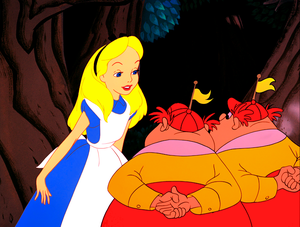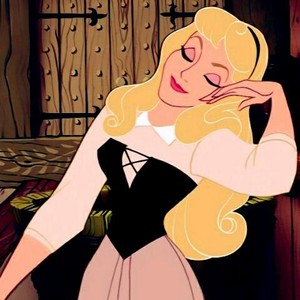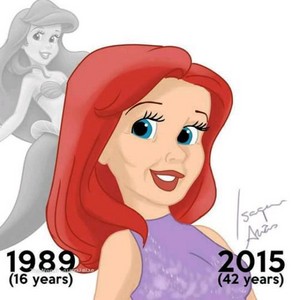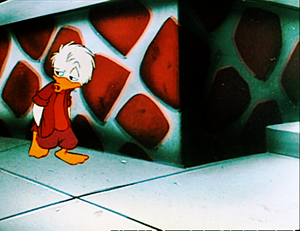The Encyclopedia of Walt Disney's Animated Characters: From Mickey ratón to Hercules by
John Grant
Walt disney Character descripción of Quasimodo from "The Hunchback of Notre Dame" (1996)
In a way, why Esmeralda should choose Phoebus as her lover rather than Quasimodo is something of a mystery. One is left with a slight puzzlement at the end of the movie, as if suddenly discovering that the romantic heroine whose adventures one has followed entranced throughout a long novel actually has a lousy taste in men. There is also a feeling of confused morality, since the primary theme of the movie - as expressed más than once in song as "who is the monster and who is the man?" - is that outward appearances are not what are important, yet Esmeralda opts for the man with the better outward appearance.
This is not to suggest, of couse, that Quasimodo is much of a looker. Quite the contrary: he is almost certainly the ugliest hero ever to have starred in an animated feature. His face is quite hideously distorted: when Esmeralda first encounters him she assumes he is wearing a deliberately grotesque mask. He has huge orange-red eyes that are of different sizes, his left eyebrow is a misshapen lump, his mouth is a twisted line and his nose is a blob - and all of this is topped por a most unappealing mass of carrot-red hair. The enormity of the face is exaggerated in the movie because often we are looking at it not straight on but from a downward angle: because of his hump, this is how most of the other characters see it. Quasimodo's arms are ungracious appendages: in shape they look más like legs of mutten than like human arms, and one would expect them to have all the subtlety of legs of mutton.
One would be wrong. Certainly those arms have colossal strength, because using them Quasimodo hauls himself around the belltower with all the agility of a chimpanzee, and on various occasions he uses them to great effect against his foes - as when he throws Frollo across the room in a late scene in the movie. Yet they are indeed capable of great subtlety - o at least the hands at the end of them are. Quasimodo's hobby, in his loneliness, is what can only be descriped as art. Central among his creations is a carved model of what he can see from the belltower, with miniature figures, exquisitelt executed, of the people most often to be observed crossing the square in front of Notre Dame. (The model also includes an accurate representation of the cathedral itself, which is a little puzzling. If Quasimodo has never been outside the cathedral, how could he know what it looks like? But that is por the by.) Others of his artefacts have been equally delicately rendered, notably a mobile constructed from what appear to be shards of variously colored glass - this mobile is what first fascinates Esmeralda when she comes to the beltower. Quasimodo's aestheticism extends beyond just creation, he is also able to perceive. Soon after Esmeralda has arrived in the belltower he shows her the vista of Paris he has looked out on since childhood; this is fittingly shown on screen as if it were a classical painting, so that we know how Quasimodo see and appreciates it.
Quasimodo is also, despite his impressive strength, most of the time exceptionally gentle and kind. This is demonstrated to us very early in the movie. A pigeon has nested in the mouth of one of the three gargoyles who are at the time Quasimodo's sole friends. Still remaining in the nest is a final chick. Although Quasimodo clearly loves the chick, it is time for the bird to learn the art of flying - to registrarse the rest of its own kind. The tenderness with which he helps it to launch itself into the air for the first time is very touching.
The story of the movie is not that of Quasimodo's amor for Esmeralda; it is the story of Quasimodo slowly beginning to realize that the man he has always regarded as a surrogate fahter - as his "master," in fact ("i'm sorry, master. I will never disobey tu again") - is a man not to be loved o respected o even trusted but is a villain of the darkest stripe: someone to be rejected. Frollo, who would have murdered the baby Quasimodo had it not been for the intervention of the cathedral's Archdeacon, has totally indoctrinated our hero, who has even accepted the name Frollo has dado him, "Quasimodo", meaning "the half-formed one". Everything Frollo says, Quasimodo has been brainwashed into believing, must necessarily be true: since he has had no real contact with anyone else, it is easy to understand how the campana ringer could have come to accept Frollo's word. It is only when he meets and falls in amor with Esmeralda that he begins to have doubts. Frollo hates gypsies and believes they should be exterminated, yet Esmeralda has saved Quasimodo from a horrific humiliation. Every lines of dialogue between the two characters go thus:
Quasimodo: But you're not like the other gypsies. They'ren evil.
Esmeralda: Who told tu that?
Quasimodo:My master. Frollo. He raised me.
Esmeralda: How can such a cruel man have raised someone like you?
Quasimodo: Cruel? Oh no. He saved my life. He took me in when no one else would. I am a monster, tu know.
Esmeralda: He told tu that?
Quasimodo: Look at me.
Esmeralda: Give me your hand.
Quasimodo: Why?
Esmeralda: Just let me see it. Hmm... A long life line. Oh, and this one means you're shy. Hmm... Hmm, hmm, hmm.... Well, that's funny.
Quasimodo: What?
Esmeralda: I don't see any...
Quasimodo: Any what?
Esmeralda: "Monster" lines. Not a singe one. [holds out her hand while Quasimodo briefly studies his own] Now, tu look at me. Do tu think I'm evil?
Quasimodo: No! No, no. tu are kind and good, and... and...
Esmeralda: And a gypsy. And maybe Frollo's wrong about the both of us.
It is the beginning of Quasimodo's faith in himself and in his own opinions. Nevertheless, it takes him a long time to build up that faith to the extent that he can defy Frollo's instructions on any matter of importance - his prohibited visit to the Feast of Fools, early in the movie, he regards as a minor impertinence that Frollo may never discover. Only when he makes a sudden decision to help Phoebus find the Court of Miracles and warn the gypsies that a renewed persecution is about to start does he finally realize the heinousness of his "master's" crimes. But still, after what is in effect Frollo's betrayal of him, he is not quite able to recognize the tyrant as anything other than his "master"; he is still a slave, still - in his own view - the "half-formed one."
One of the most heinous of all Frollo's crimes, of course, was the gratuitous murder of Quasimodo's mother. All through the movie until very close to the end, Frollo has claimed that Quasimodo is alone because his mother cast him off at birth. It is only when Frollo confesses the lie that Quasimodo's resentment and self-faith become complete. Although he does his best to save Frollo's life while they are both dangling on the frontage of Notre Dame (another indication of the innate gentleness of his character), there is little evidence of regret after Frollo falls to his doom.
Quasimodo is - as who wouldn't be - mightily depressed in the later stages of the movie when he discovers that Esmeralda's affections are directed toward Phoebus rather than him, the gargoyles having persuaded him that the opposite might be the case. Yet in the conclusion he gently places her hand in Phoebus's, thereby symbolically giving his sello of approval to the love-match. It is yet another touching moment.
disney wrung as much emotion as it could out of this facially hideous character. The result could have been schmaltz. Instead, the animators succeeded in creating one of their most appealing characters of all time.
John Grant
Walt disney Character descripción of Quasimodo from "The Hunchback of Notre Dame" (1996)
In a way, why Esmeralda should choose Phoebus as her lover rather than Quasimodo is something of a mystery. One is left with a slight puzzlement at the end of the movie, as if suddenly discovering that the romantic heroine whose adventures one has followed entranced throughout a long novel actually has a lousy taste in men. There is also a feeling of confused morality, since the primary theme of the movie - as expressed más than once in song as "who is the monster and who is the man?" - is that outward appearances are not what are important, yet Esmeralda opts for the man with the better outward appearance.
This is not to suggest, of couse, that Quasimodo is much of a looker. Quite the contrary: he is almost certainly the ugliest hero ever to have starred in an animated feature. His face is quite hideously distorted: when Esmeralda first encounters him she assumes he is wearing a deliberately grotesque mask. He has huge orange-red eyes that are of different sizes, his left eyebrow is a misshapen lump, his mouth is a twisted line and his nose is a blob - and all of this is topped por a most unappealing mass of carrot-red hair. The enormity of the face is exaggerated in the movie because often we are looking at it not straight on but from a downward angle: because of his hump, this is how most of the other characters see it. Quasimodo's arms are ungracious appendages: in shape they look más like legs of mutten than like human arms, and one would expect them to have all the subtlety of legs of mutton.
One would be wrong. Certainly those arms have colossal strength, because using them Quasimodo hauls himself around the belltower with all the agility of a chimpanzee, and on various occasions he uses them to great effect against his foes - as when he throws Frollo across the room in a late scene in the movie. Yet they are indeed capable of great subtlety - o at least the hands at the end of them are. Quasimodo's hobby, in his loneliness, is what can only be descriped as art. Central among his creations is a carved model of what he can see from the belltower, with miniature figures, exquisitelt executed, of the people most often to be observed crossing the square in front of Notre Dame. (The model also includes an accurate representation of the cathedral itself, which is a little puzzling. If Quasimodo has never been outside the cathedral, how could he know what it looks like? But that is por the by.) Others of his artefacts have been equally delicately rendered, notably a mobile constructed from what appear to be shards of variously colored glass - this mobile is what first fascinates Esmeralda when she comes to the beltower. Quasimodo's aestheticism extends beyond just creation, he is also able to perceive. Soon after Esmeralda has arrived in the belltower he shows her the vista of Paris he has looked out on since childhood; this is fittingly shown on screen as if it were a classical painting, so that we know how Quasimodo see and appreciates it.
Quasimodo is also, despite his impressive strength, most of the time exceptionally gentle and kind. This is demonstrated to us very early in the movie. A pigeon has nested in the mouth of one of the three gargoyles who are at the time Quasimodo's sole friends. Still remaining in the nest is a final chick. Although Quasimodo clearly loves the chick, it is time for the bird to learn the art of flying - to registrarse the rest of its own kind. The tenderness with which he helps it to launch itself into the air for the first time is very touching.
The story of the movie is not that of Quasimodo's amor for Esmeralda; it is the story of Quasimodo slowly beginning to realize that the man he has always regarded as a surrogate fahter - as his "master," in fact ("i'm sorry, master. I will never disobey tu again") - is a man not to be loved o respected o even trusted but is a villain of the darkest stripe: someone to be rejected. Frollo, who would have murdered the baby Quasimodo had it not been for the intervention of the cathedral's Archdeacon, has totally indoctrinated our hero, who has even accepted the name Frollo has dado him, "Quasimodo", meaning "the half-formed one". Everything Frollo says, Quasimodo has been brainwashed into believing, must necessarily be true: since he has had no real contact with anyone else, it is easy to understand how the campana ringer could have come to accept Frollo's word. It is only when he meets and falls in amor with Esmeralda that he begins to have doubts. Frollo hates gypsies and believes they should be exterminated, yet Esmeralda has saved Quasimodo from a horrific humiliation. Every lines of dialogue between the two characters go thus:
Quasimodo: But you're not like the other gypsies. They'ren evil.
Esmeralda: Who told tu that?
Quasimodo:My master. Frollo. He raised me.
Esmeralda: How can such a cruel man have raised someone like you?
Quasimodo: Cruel? Oh no. He saved my life. He took me in when no one else would. I am a monster, tu know.
Esmeralda: He told tu that?
Quasimodo: Look at me.
Esmeralda: Give me your hand.
Quasimodo: Why?
Esmeralda: Just let me see it. Hmm... A long life line. Oh, and this one means you're shy. Hmm... Hmm, hmm, hmm.... Well, that's funny.
Quasimodo: What?
Esmeralda: I don't see any...
Quasimodo: Any what?
Esmeralda: "Monster" lines. Not a singe one. [holds out her hand while Quasimodo briefly studies his own] Now, tu look at me. Do tu think I'm evil?
Quasimodo: No! No, no. tu are kind and good, and... and...
Esmeralda: And a gypsy. And maybe Frollo's wrong about the both of us.
It is the beginning of Quasimodo's faith in himself and in his own opinions. Nevertheless, it takes him a long time to build up that faith to the extent that he can defy Frollo's instructions on any matter of importance - his prohibited visit to the Feast of Fools, early in the movie, he regards as a minor impertinence that Frollo may never discover. Only when he makes a sudden decision to help Phoebus find the Court of Miracles and warn the gypsies that a renewed persecution is about to start does he finally realize the heinousness of his "master's" crimes. But still, after what is in effect Frollo's betrayal of him, he is not quite able to recognize the tyrant as anything other than his "master"; he is still a slave, still - in his own view - the "half-formed one."
One of the most heinous of all Frollo's crimes, of course, was the gratuitous murder of Quasimodo's mother. All through the movie until very close to the end, Frollo has claimed that Quasimodo is alone because his mother cast him off at birth. It is only when Frollo confesses the lie that Quasimodo's resentment and self-faith become complete. Although he does his best to save Frollo's life while they are both dangling on the frontage of Notre Dame (another indication of the innate gentleness of his character), there is little evidence of regret after Frollo falls to his doom.
Quasimodo is - as who wouldn't be - mightily depressed in the later stages of the movie when he discovers that Esmeralda's affections are directed toward Phoebus rather than him, the gargoyles having persuaded him that the opposite might be the case. Yet in the conclusion he gently places her hand in Phoebus's, thereby symbolically giving his sello of approval to the love-match. It is yet another touching moment.
disney wrung as much emotion as it could out of this facially hideous character. The result could have been schmaltz. Instead, the animators succeeded in creating one of their most appealing characters of all time.


